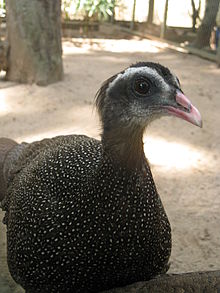Rheinardia
| Crested argus | |
|---|---|
 |
|
| Female | |
| Scientific classification | |
| Kingdom: | Animalia |
| Phylum: | Chordata |
| Class: | Aves |
| Order: | Galliformes |
| Family: | Phasianidae |
| Subfamily: | Phasianinae |
| Genus: |
Rheinardia Maingonnat, 1882 |
| Species: | R. ocellata |
| Binomial name | |
|
Rheinardia ocellata (Elliot, 1871) |
|
The crested argus (Rheinardia ocellata) are large and spectacular pheasant like-peafowl with dark-brown-spotted black and buff plumage, a heavy pink bill, brown irises and blue skin around the eyes. The head has two crests; the hind crest, which extends down the occiput, is erected when alarmed and during intentional behaviors including pair bonding and courtship displays. The male has a broad and greatly elongated tail of twelve feathers. The tail covert (or "train") of the male is the longest of any bird and is believed to contain the longest (and widest) feathers to occur in a wild bird; the Reeves's pheasant has tail feathers of similar length but which are considerably narrower. The tail coverts measure up to 1.73 m (5.7 ft) in length, giving the bird a total length of 1.9–2.39 m (6.2–7.8 ft).
The female is similar in size, with a prominent marbled barring and more colourful dorsal plumage than the male. Her conspicuous white facial plumage is like the male, marked with disruptive patterning. The female's crest is different morphologically, with more rigid plumes that take up more surface area along the occiput and upper hind neck. The female's tail is elongated and laterally compressed as is that of the male but of considerably shorter length. The average length of the female is 74–75 cm (2.43–2.46 ft). There are two species in genus Rheinardia. The Malaysian R. nigrescens, inhabits the Malaysian Isthmus and the Annamese inhabits the Annametic Mountain Range. Despite being sexually dimorphic galliform by length, the male only weighs about 20% more than the female. The average weight is around 1.5 kg (3.3 lb).
The wings of the crested argus are of unusual size and length for its weight. They wide and square like those of Argusianus versus rounded and abbreviated like those of True Pheasants. Additionally, there is no discernible trailing edge secondary wing notch amongst the flight feathers, indicating a capacity of sustained flight in species of this genus. They are morphologically similar to the wings of certain semi-arboreal Craciformes, particularly Guans of the genus Pipile. The feet and legs of crested argus are also notable in the presence of curiously developed leg scales in males which are widened in such a matter that they give each limb the appearance of the foreleg of a Varanid Lizard. The toes are long and gracile and like other peafowls, the hind toe is less recumbent than those of more strictly terrestrial Galliformes.
...
Wikipedia

